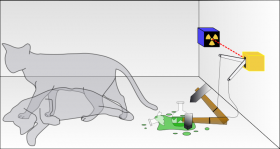September 24, 2009 weblog
Schrodinger's Cat Experiment Proposed

(PhysOrg.com) -- One of the classical problems in quantum mechanics concerns a man and his feline companion. The man has placed his cat in an opaque tank and is slowing pumping it full of poison. Now until the man opens the tank and looks inside, he cannot be sure whether the cat is dead or alive. That is to say, the cat is both dead and alive at the same time. Impossible but such is the nature of the problem that faced this man. The man's name is Erwin Schrodinger and the problem is that of his Uncertainty Principle.
For nearly a century, his problem has remained a quixotic quest for physicists. Particle physics has always held that matter can only exist at one state in one time. That is why particles are classified as moving with an up or down spin but nothing in between. In recent years that rule has been bent with the superposition of atoms and other nonliving things. Superposition is the term for an object that is not being observed that exists as both possibilities: up and down, dead and alive. This allows physicists to observe the matter in two different states at the same time. However, thus far it has only been done with non-living things. A life-form has never been superimposed. Now, one physicist says he may have an answer.
Oriol Romero-Isart is at the Max Planck Institute for Quantum Physics in Garching in Germany. Along with his team he is proposing a "Schrodinger's virus" experiment that would follow the same general principles of Schrodinger's Cat. Using an electromagnetic field created by a laser, the virus would be trapped in a vacuum. Then, using another laser, the virus will be slowed down until it lies motionless in its lowest possible energy state.
Now that the virus is fixed, a single photon is used to put the virus into a superposition of two states, moving and non-moving. Up until the point is measured it is in both states. Only after a measurement is it found to be in one state and one alone. The team has suggested that the tobacco mosaic virus be used. The virus is rod-shaped and measures 50 nanometers wide and approximately 1 micrometer long. There is debate however, whether the virus can truly be classified as "alive." However the scientists are confident that the treatment could be extended to tiny micro-organisms such as tardigrades who can survive in vacuum for days, making them suitable for the "Schrodinger treatment."
However, physicists are doubtful about the experiment's results. Martin Plenio of Imperial College in London says that there is little reason that a virus would behave any differently than a similarly-sized inanimate object. However, there are possibilities in testing large objects such as viruses and molecules. This is because quantum mechanics says that macroscopic objects can enter superposition however, it has never happened. Through these studies, Plenio believes that we will finally be able to bridge the divide between the quantum world and our own macroscopic world.
More information:
• Towards Quantum Superposition of Living Organisms, arxiv.org/abs/0909.1469
• Schrödinger's cat on Wikipedia.
© 2009 PhysOrg.com


















